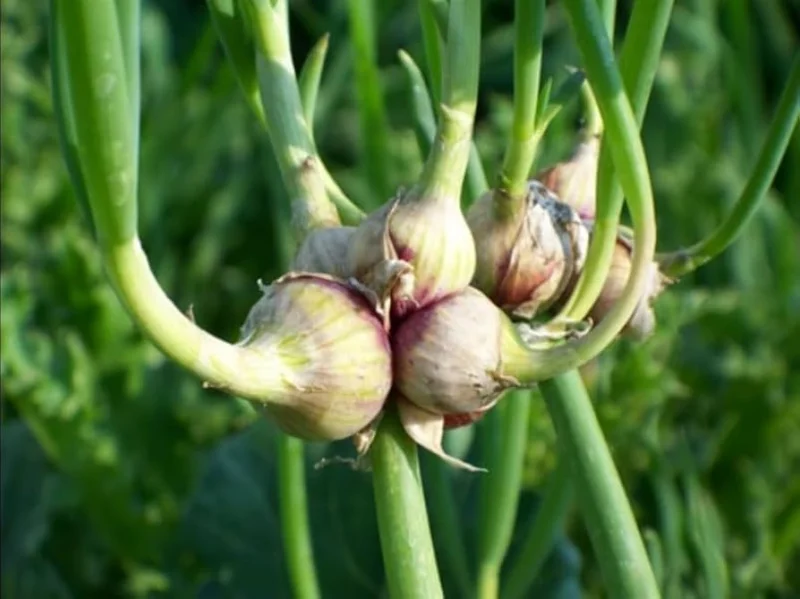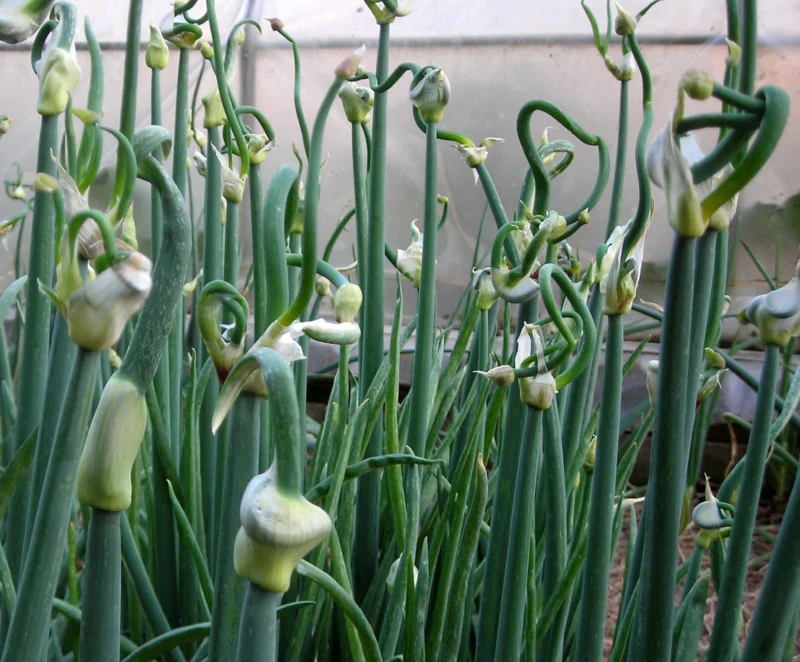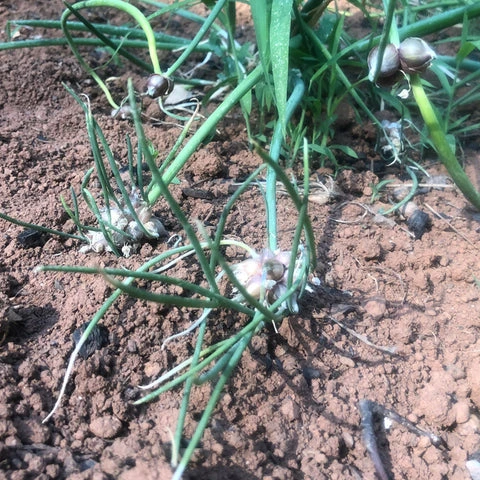Are you fascinated by growing a unique and self-sustaining onion variety in your garden? Egyptian walking onions, also known as tree onions or top-setting onions, are perennial vegetables that are easy to grow, incredibly hardy, and perfect for home gardeners. These onions are named for their remarkable ability to “walk” across your garden by producing bulbils that replant themselves. Here’s a comprehensive guide to help you successfully grow these fascinating plants.
What Are Egyptian Walking Onions?

Egyptian walking onions were known by many names, including topsetting onions, tree onions, winter onions, perennial onions, and their botanical name, Allium x proliferum. This self-sustaining perennial onion variety is known for its unique growth pattern.
Instead of producing seeds, they grow small bulbils on top of their stems, which eventually fall to the ground and sprout new plants. These bulbs are at the top of the plant – each with numerous small onions that you can harvest for planting or eating. This self-propagating behavior gives them the appearance of “walking” across your garden.
Key Features
-
Perennial Growth: These onions come back year after year.
-
Self-Propagating: Bulbils replant themselves, spreading naturally.
-
Hardy Plant: They can withstand harsh weather conditions.
-
Edible Parts: The bulbils, stalks, and underground bulbs are all edible.
Why Grow Egyptian Walking Onions?
Benefits for Gardeners
- Minimal maintenance once established.
- Multi-use harvest: edible bulbils, stalks, and underground bulbs.
- Ideal for gardeners in USDA zones 3-9, with reports of success in zone 10.
- Adaptable to containers, small gardens, or raised beds.
Planting Egyptian Walking Onions

1. Choosing the Right Location
Egyptian Walking Onions are resilient perennials, thriving in USDA planting zones 3 to 9, and some gardeners report success even in zone 10.
These hardy plants start producing green tops in late winter, even in cooler climates. They can also endure early frosts and snowfall, making them well-suited for colder regions.
Choosing the perfect spot for your Egyptian walking onions is crucial for their growth and productivity.
-
Sunlight: These onions thrive in full sunlight, so select a location that receives 6-8 hours of direct sun daily. This ensures healthy growth and robust bulb production.
-
Space: Since these plants have a unique “walking” growth pattern, it’s essential to provide ample space. Leave enough room for the bulbils to fall and establish new plants without overcrowding.
2. Soil Preparation
Preparing the soil correctly is the foundation for healthy growth. Egyptian walking onions prefer:
-
Well-Draining Soil: Ensure your garden soil allows water to drain easily to prevent root rot.
-
Nutrient-Rich Amendments: Incorporate organic compost or well-rotted manure to enrich the soil and maintain fertility.
-
Optimal pH Levels: Aim for a neutral to slightly acidic soil pH (6.0-7.0). Use a soil test kit to determine and adjust your soil’s pH if needed.
3. Planting Instructions
Getting the planting process right ensures your Egyptian walking onions thrive. Follow these steps:
-
Planting Season: Plant in the fall for a strong start or early spring for a quick harvest.
-
Depth and Spacing:
-
Plant bulbils 1 inch deep with the pointed end facing up.
-
Space them 4-6 inches apart in rows about 12 inches apart to give them room to grow.
-
-
Initial Watering: Water thoroughly after planting to help establish roots.
4. Container Planting Tips
Limited space doesn’t mean you can’t grow Egyptian walking onions. Here’s how to succeed with container gardening:
-
Choose the Right Pot: Use a deep container (at least 12 inches) with good drainage holes.
-
Potting Mix: Fill the pot with high-quality, well-draining potting soil.
-
Placement: Position the container in a spot that receives plenty of sunlight. Rotate the pot periodically to ensure even growth.
For general tips on growing onions, check out our detailed guide on how to grow onions.
Caring for Egyptian Walking Onions
The time it takes for onion greens to emerge depends on when you plant—ranging from a few days to several weeks. In their first year, Egyptian Walking Onions typically don’t produce top-set bulbs. However, if planted in the fall or early spring, you might be able to harvest the underground multiplier bulbs within the first year.
By the second year, top-set bulbs should develop, though they may initially be small. Over time, these bulbs tend to grow larger with each passing year. It’s common for older, more established plants to produce top sets on top of other top sets, showcasing their vigorous growth.
By the third year, you’ll need to divide the underground bulbs to prevent overcrowding. This involves digging up and harvesting the outer bulbs for eating or replanting, ensuring the plants stay healthy and productive.
Watering
Consistent watering is essential for healthy plants. Here’s what to do:
-
Frequency: Water deeply once a week or more frequently during dry periods.
-
Avoid Overwatering: Let the soil dry out slightly between waterings to prevent fungal issues.
Fertilizing
Feeding your onions properly supports robust growth. Follow these tips:
-
Timing: Apply a balanced fertilizer (10-10-10) in early spring and mid-summer.
-
Organic Alternatives: Use compost tea or fish emulsion for a natural nutrient boost.
-
Avoid Over-Fertilizing: Excessive fertilizer can cause excessive leaf growth at the expense of bulb development.
Pruning
Maintaining your plants helps them stay productive.
-
Remove Damaged Parts: Trim any yellowing or dead leaves to keep plants healthy.
-
Manage Height: Cut back overly tall stalks if they begin to flop over and block sunlight to other parts of the plant.
Winter Care
Egyptian walking onions are hardy, but a little extra care ensures their survival through harsh winters:
-
Mulching: Apply a thick layer of mulch (straw or shredded leaves) around the plants to insulate them.
-
Minimal Maintenance: In mild climates, onions often need no additional winter protection.
Potting and Repotting
Container-grown onions may need occasional repotting:
-
Refresh Soil: Every 2-3 years, replace the potting mix to replenish nutrients.
-
Increase Space: Transfer to a larger container if roots become crowded.
How to Propagate Egyptian Walking Onions

Egyptian walking onions make propagation simple. Use these methods:
-
Using Bulbils:
-
Harvest bulbils once they mature and dry on the plant.
-
Plant them immediately or store them in a cool, dry place until the next growing season.
-
-
Dividing Clumps:
-
Dig up and separate mature underground bulbs into smaller clusters.
-
Replant them in fresh soil to encourage new growth.
-
How to Use Egyptian Walking Onions
Culinary Uses
These onions are versatile in the kitchen:
-
Bulbils: Perfect as garnishes or in salads and stir-fries.
-
Stalks: Use like green onions in soups, sautés, or casseroles.
-
Underground Bulbs: Substitute for traditional onions in recipes.
Preservation
Extend the harvest with these methods:
-
Freezing: Chop bulbils and stalks, then freeze them in airtight bags.
-
Drying: Dehydrate and grind into onion powder for long-term storage.
Common Problems and Solutions
Pests
Protect your plants with these strategies:
-
Onion Maggots:
-
Use floating row covers to block egg-laying flies.
-
Rotate crops annually to break pest life cycles.
-
-
Thrips:
-
Spray plants with neem oil or insecticidal soap.
-
Diseases
Prevent common diseases with proactive care:
-
Downy Mildew:
-
Avoid overhead watering to reduce humidity around the plants.
-
Space plants appropriately for better air circulation.
-
-
Rot:
-
Ensure proper drainage in your planting area to prevent waterlogged soil.
-
Overcrowding
Thin plants as needed:
-
Why Thin: Prevent competition for resources and improve overall growth.
-
How To Thin: Remove weaker plants, leaving only the healthiest ones.
FAQs About Egyptian Walking Onions
-
Can Egyptian walking onions grow in all climates?
-
They thrive in USDA zones 3–9 and can tolerate a wide range of conditions.
-
-
How do I control their spread?
-
Harvest bulbils before they drop to control their self-propagation.
-
-
Are they suitable for small gardens?
-
Yes! Plant them in containers or raised beds to manage space.
-
-
What’s the best time to harvest?
-
Harvest bulbils in late summer and underground bulbs in early fall.
-
Conclusion
Egyptian walking onions are an excellent addition to any garden. They’re hardy, low-maintenance, and provide multiple harvestable parts for culinary use. Whether you’re an experienced gardener or a beginner, this unique plant offers both functionality and intrigue. Start planting today and enjoy watching your onions “walk” through your garden!
